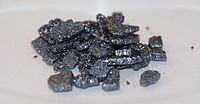
Photo from wikipedia
The present paper discloses an ultrasonication strategy assisted by molecular iodine as an environmentally benign catalyst leading to the synthesis of pharmacologically significant imidazo[1,2-a]pyridine scaffolds. The molecular-iodine-catalyzed approach for the… Click to show full abstract
The present paper discloses an ultrasonication strategy assisted by molecular iodine as an environmentally benign catalyst leading to the synthesis of pharmacologically significant imidazo[1,2-a]pyridine scaffolds. The molecular-iodine-catalyzed approach for the synthesis of biologically active synthetic equivalents was achieved through three-component coupling embracing 2-aminopyridine derivatives, pertinent acetophenones, and dimedone in water medium under aerobic conditions. The higher product yield (up to 96%) with a miniature reaction time and modest catalyst loading as demonstrated by higher ecological compatibility and sustainability factors are fascinating features of this protocol. The structures of synthesized compounds were accomplished through FT-IR, 1H NMR,13C NMR, mass, and elemental analysis data. The virtual screening of synthetic moieties was performed to ascertain the in silico selectivity and binding affinities against several biological targets. Lipinski’s rules of five, ADMET, and TOPKAT descriptors were used to evaluate the drug-likeness assets. Furthermore, a quantum computational study was computed at the B3LYP/6-311G++(d,p) level of theory to investigate the density functional theory-based chemical reactivity parameters and HOMO–LUMO energy gap of the synthesized derivatives. The present studies open the way for in vitro and in vivo testing of synthesized derivatives as potent inhibitors with an improved pharmacological profile against farnesyl diphosphate synthase, phosphodiesterase III, CXCR4, and GABAa receptor agonists.
Journal Title: ACS Omega
Year Published: 2022
Link to full text (if available)
Share on Social Media: Sign Up to like & get
recommendations!